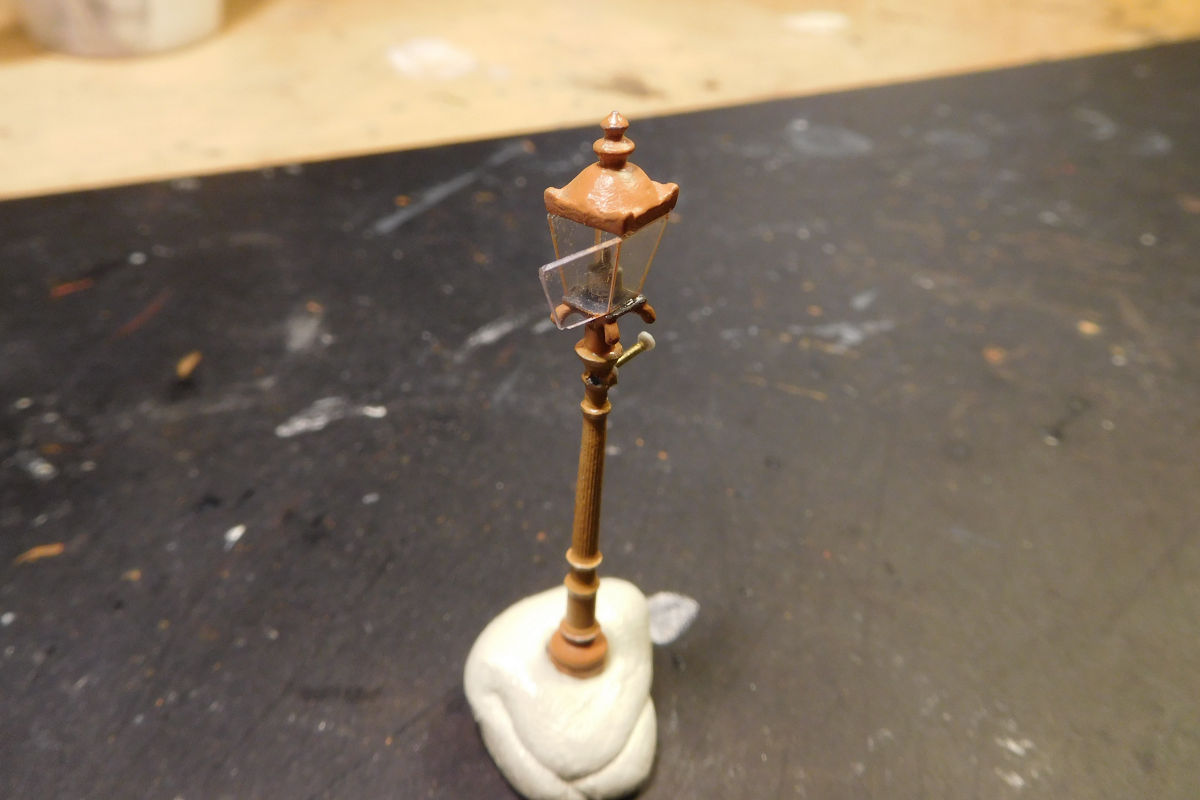Yard lamps have appeared at Farthing, using a mix of scratchbuilt bits, modified parts from old whitemetal lamps, and modified Andrew Stadden figures.
This is an early GWR platform type, based on old photos I have found. There was also a later, more sturdy variant. Thomas Grig, GWR Yard Porter and lamplighter, is looking a trifle worried. He never did like heights.
Above is a standard 13ft column lamp. Most GWR yard lamps had hexagonal lamp housing, but the style and decoration of the chimney varied greatly. This one is based on a photo in Vaughan’s "GWR Architecture".
On some of the taller lamp types, a ladder was fixed permanently at the center. I assume this was safer than using the cross bars.
The Old Yard at Farthing was formerly a station on the erstwhile N&SJR line. A few of the original lamps survived the GWR takeover, as seen here front left. These are modified from the old Mike' Models range.
GWR porter Herbert Pocket prepares to clean a lamp. Thanks to Richard whose suggestion inspired this little scene.
Herbert discovers that the chimney glass is broken. It's a proper mystery how that happened.
The lamps were cobbled together from various parts in my spares box. Here the post from an old Dart Castings lamp is being modified with cross bars and curly bits from brass wire.
The glazing on all the lamps was drawn up in Inkscape, then cut and scored on my Silhouette cutter. I used 0,25mm (i.e. 10 thou) PVC glazing from the German “Aeronaut Modellbau” range (ref #7858/32).
The glazing is simply folded into shape.
Here is a hexagonal example being folded for the GWR lamps.
To represent glazing bars, I filled the folding lines with paint and removed the excess. After taking these photos I discovered that it pays to use a darker shade than for the rest of the lamp for this purpose.
Frosting was initially a problem, as I used Superglue to fix the glazing in place. However, leaving one "window" open helped the fumes escape. The last bit was then fixed with glazing glue. On future lamps, I will see if a more appropriate glue can be used.
The tops on the GWR lamps were built up using prototype photos, bits from the spares box and some plastic rod. In retrospect it would be better to fashion the lamp top cover from styrene as well, using the cut and fold technique.
I tried different ways of making the glass chimneys, all with mixed success. I think the most promising way was to use bits cut from "fine glue applicators", i.e. thin plastic tube.
The glass chimney in evidence. Looks like I didn't fit it straight. Never mind, time to get on with life :-)
Speaking of life: The lamp attendants were made from Andrew Stadden figures. Their limbs bend fairly easily, another advantage of these great figures. Thomas Grig had his arms and legs bent for a suitable pose.
Looks like Thomas has made use of a fireman's jacket for the grubby work of tending the lamps.
Herbert Pocket was made from one of Andrew Stadden's loco crews, which come with separate arms and heads. The photos below show how:
I have enjoyed making these lamps. With further experiments they could probably be refined further, but for now I'm happy with them.
A final look at Thomas Grig as he surveys the scene. He is in dire need of some equipment for tending that lamp - currently on the workbench.
























